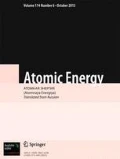The growth prospects for nuclear power are examined: impeding and driving forces. The main problem facing nuclear power today is the management of spent fuel and wastes. Eventually, it will become economically inexpedient to store spent fuel; the natural solution is to reprocess spent fuel, extract the fi ssile isotopes, and recycle it in thermal or fast reactors. Since the fast-reactor fraction in the current system is trivial and the situation will remain the same in the near- and medium-term futures, a variant of plutonium recycling in thermal reactors with a different fuel arrangement is examined. It is shown that a heterogeneous fuel arrangement can give a 10-fold reduction of the radiation load in reprocessing enterprises. Different setups are compared in terms of the potential danger presented by spent-fuel reprocessing. The advantages of the thorium fuel cycle are examined from the standpoint of radiation and environmental safety.
Similar content being viewed by others
References
V. D. Davidenko and S. V. Tsibul’skii, “Effi cient methods of burning power-grade plutonium in VVER,” At. Énerg., 118, No. 3, 134–136 (2015).
N. G. Kodochigov, Yu. P. Sukharev, E. V. Marova, et al., “Computational-experimental investigations of the neutronphysical characteristics of the core of the GT-MHR reactor,” At. Énerg., 102, No. 1, 63–68 (2007).
Yu. P. Sukharev and P. A. Fomichenko, “GT-MHR project high-temperature reactor neutronic issues and ways to resolve them,” Nucl. Eng. Design, 271, 392–396 (2014).
B. V. Kuteev, E. A. Azizov, and P. N. Alexeev, “Development of DEMO-FNS tokamak for fusion and hybrid technologies,” Nucl. Fus., 55, No. 7, 073035 (2015).
E. P. Velikhov, M. V. Koval’chuk, E. A. Azizov, et al., “Thermonuclear source of neutrons for the production of nuclear fuel,” At. Énerg., 114, No. 3, 160–165 (2013).
S. M. Feinberg, “Breeder with gaseous coolant, as an alternative to metallic coolant: ideology of hard and soft spectra,” in: Distinguished Scientists of the Kurchatov Institute, Moscow (2011), pp. 135–165.
E. A. Andrianova, V. D. Davidenko, and V. F. Tsibul’skii, “Prospective fuel loads of reactors for a closed fuel cycle of nuclear power,” At. Énerg., 118, No. 5, 243–247 (2015).
Author information
Authors and Affiliations
Additional information
Translated from Atomnaya Énergiya, Vol. 120, No. 5, pp. 243–249, May, 2016.
Rights and permissions
About this article
Cite this article
Tsibul’skii, V.F., Andrianova, E.A., Davidenko, V.D. et al. Fundamental Principles of the Formation of an Efficient Fuel-Cycle Structure for Nuclear Power. At Energy 120, 299–304 (2016). https://doi.org/10.1007/s10512-016-0134-7
Received:
Published:
Issue Date:
DOI: https://doi.org/10.1007/s10512-016-0134-7




